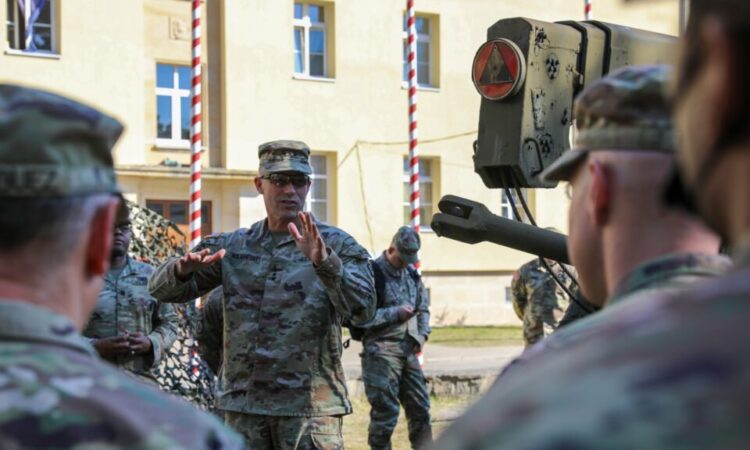

U.S. Army Lt. Gen. John S. Kolasheski, commanding general of U.S. Army V Corps, speaks with soldiers assigned to 1st Armored Brigade Combat Team, 1st Infantry Division, at Zagan, Poland, March 23, 2022. (U.S. Army photo by Joseph Aleman)
AUSA 2022 — Russia’s invasion of Ukraine has led to a “historic opportunity” for the NATO alliance, according to the Army’s V Corps commander, as the treaty organization is positioned to expand and current members signal enthusiasm for spending on defense modernization.
“There really is a historic opportunity that we are seeing in Europe,” Lt. Gen. John Kolasheski, commander of the V Corps, said today at the annual Association of the United States Army conference. “[There are] potentially two new members. You’ve got militaries and government that are willing to invest in their militaries.”
In May, Finland and Sweden formally requested to join the Atlantic treaty group following decades of neutrality during the Cold War. The US Senate ratified Sweden and Finland to NATO at the beginning of August. All 30 NATO nations have to ratify a new member before they can join. Hungary and Turkey are the remaining hold outs.
“This is probably the most significant strategic event in Nordic history since the Second World War,” Maj. Gen. Lars S. Lervik, chief of the Norwegian army, on the same panel. “It is a game-changer.”
Lervik said that both the Finns and Swedes bring a “very, very capable” military force into the NATO and presents the Russian military with major strategic challenges in the Baltic Sea because all nations sharing coastline will be NATO allies — except for Russia.
“It will have significant strategic importance for how the Russians perceive their area in Kaliningrad and also the St. Petersburg area,” Lervik said. “This is good news and it will increase our overall security.”
On the financial front, US leaders have been pleased to see the level of military spending in NATO increase in response to Russia’s invasion of Ukraine. For years, the fact that NATO allies were spending below the required two-percent GDP threshold on defense was a source of tension within the alliance — particularly under the Trump administration. But since the invasion, multiple countries in Europe have announced significant military investment.
“That is money to modernize their equipment and replenish their stocks, but also money to train their forces,” said Kolasheski, whose V Corps’ forward command is based in Poland and has served in Europe for decades.
But while European nations set major military spending goals, the question remains whether they will continue that level of spending in the future — especially after the jolt of Russia’s invasion wears off. For some to reach their modernization goals, they’d have to.
Gen. Chris Cavoli, the US European Command and Supreme Allied Commander Europe, told lawmakers earlier this year that he supports NATO nations spending beyond the 2 percent threshold required by NATO.
“I know all of the land forces chiefs in NATO. Each one of them has a list of requirements. The requirements …would all take more than 2 percent of GDP,” Cavoli said. “So I am an advocate of spending more than 2 percent — at least 2 percent.”






